|
Oct, 2024


The setting sun signals humans to unwind and rest, but for Minnesota’s nocturnal wildlife, it’s time to rev up for a night full of activity.
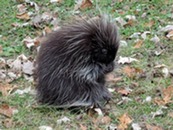
Porcupine
While they can be active during the day, porcupines are most active at night. These large, slow moving rodents travel out from their den in search of food. They eat almost anything, from tree buds to canoe paddles. They are found throughout most of northern Minnesota and all along our state’s eastern border, especially in forests.
Photo by Heidi Wojahn
|
Barn spider
Every evening, the female barn spider spins a new web. She will sit motionless at its center, waiting for her prey to be snared. When morning comes, she will eat her prey and web before curling up under a leaf, sleeping the day away on a full stomach.
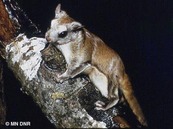
Flying squirrel
Yes, Minnesota has flying squirrels! In fact, we have two species of flying squirrels: the southern flying squirrel (Glaucomys volans), and the northern flying squirrel (Glaucomys sabrinus). Both are quite active at night and can be found in central and northeast Minnesota’s woodlands, forests and tree-filled neighborhoods.
|
Milk snake
When the sun sets, milk snakes slither out for the hunt. These beautifully patterned snakes are harmless to humans, but not to mice, small mammals or other even other snakes. Milk snakes use their many muscles to constrict and capture their prey before swallowing them whole. They are found in southern Minnesota, but don’t let their shaking tail fool you. Milk snakes aren’t rattlesnakes, and you can tell them apart from real rattlesnakes by their brown or red markings outlined in black.
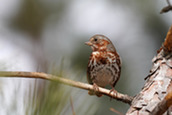
Birds
During the fall, millions of birds spend their night flying south for the winter. Track which birds are flying overhead with BirdCast, and remember to turn off your unnecessary lights at night to help birds stay on their way.
Photo of a fox sparrow, by USFWS
|

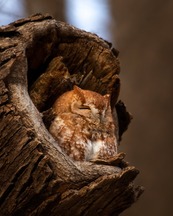
A barking scream, a whinny in the woods. What are all these weird nighttime noises?
Eastern screech owl
Despite their name, eastern screen owls don’t actually screech, but they do sound eerie. They have two main calls: a tremolo and a whinny. The tremolo is their more common call, a soft, distant-sounding trill used by mated pairs. Their whinny is a series of shrill, descending notes, much like a horse’s whinny. They use this call when they are defending their territory.
Red fox
Red foxes have several calls, including the “vixen scream.” This is a piercing screech that sounds very similar to a human’s scream. They use this call during their mating season, which usually runs from December to February.
Coyote
Howling, yipping and barking are all nighttime noises of the coyote. When mating pairs are establishing territories, they will howl to announce their presence. Nearby pairs may also respond to announce their territory, resulting in a cascade of howls.
Cricket
You may think that a cricket’s call is a sound of summer, but some species (like the fall field cricket) will continue calling through October.
Photo of an eastern screech owl, taken by USFWS
|

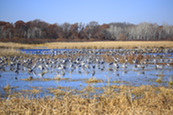
Leaf peeping is fun, but have you ever been bird peeping?
Fall is a perfect time to get out birding, and we’ve found some excellent bird watching spots for you to enjoy.
🐦 Minnesota Scientific and Natural Areas (SNA) are beautiful natural areas found all over the state. Explore this list of SNAs to visit for birding. Each SNA has a birding checklist you can print off or download before you visit.
🍂 The National Eagle Center in Wabasha is nestled next to the Mississippi River, a migration highway where you can spot raptors, waterfowl and songbirds flying south for the winter.
🐦 Duluth’s Hawk Ridge Bird Observatory is one of the best places in Minnesota to watch raptor migration. Hundreds of hawks, eagles, vultures and more fly overhead in the fall.
🍂 Minnesota state parks are known for their amazing fall colors, but they should also be known for their amazing birds. Many parks even have binoculars and bird guides you can check out at the park office for free.
🐦 During October, thousands of sandhill cranes (pictured) and other bird species gather at Sherburne National Wildlife Refuge on their journey south.
🍂 One of the best places to go bird peeping this fall is in your backyard or neighborhood. You might be surprised by how many birds you can find right outside your door.
Photo of sandhill cranes at Sherburne National Wildlife Refuge, USFWS
|
|
Come visit the Nongame Wildlife Program at the Minnesota Bat Festival 🦇
This annual celebration will be held from 10 a.m. to 3 p.m. Saturday, Oct. 26, at the Minnesota Valley National Wildlife Refuge in Bloomington. This is a great family event, with lots of bat related activities, a live bat demonstration and food trucks. We hope to see you there!
Photo of a tricolored bat hibernating in cave with a band.
|
|
 |


This spring and summer, we focused on the statewide Frog and Toad Calling Survey and Chimney Swift Roost monitoring. We had great results on both fronts.
The statewide Frog and Toad Calling Survey is a long-running program that monitors the distribution and population trends of frogs and toads in Minnesota. This year, our dedicated volunteers collected data despite heavy rain, high water and changes to program protocol. Volunteers documented new locations of bullfrogs, indicating that their range in Minnesota is likely expanding. They also found new locations of the state endangered Blanchard’s cricket frog, a sign that they are re-establishing in Minnesota.
Chimney swifts are small, acrobatic birds that hunt insects in the air and roost together in vertical structures such as chimneys. In the fall, thousands of birds can roost together in the same structure, offering quite a display. In partnership with the Urban Bird Collective, our Chimney Swift Roost monitoring program revealed several new roosts around St. Paul and Minneapolis. We also held several Swift Nights Out, for the public to join us in observing the spectacle of hundreds of swifts gathering into a roost and to help us count the birds. These events were held at a large, established roost at Mahtomedi High School. At a few of these events, we saw merlins, a small falcon native to Minnesota, swooping in to hunt the swifts. They seem to have learned that roosting swifts are a predictable source of food and took advantage of the opportunity.
If you are interested in participating in the Nongame Wildlife Program’s community science projects, please follow our newsletters and Facebook page for additional information and updates. We will be recruiting volunteers beginning this winter.
Photo is from a Swift Night Out at Mahtomedi High School
|

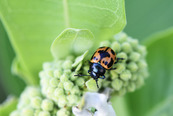
Beetlejuice, Beetlejuice, Beetle…s are a really fascinating species!
There are over 200 known beetle species in Minnesota, each with unique coloring and characteristics. Learn more about them in "Beetlemania!" by Val Cervenka.
|
|